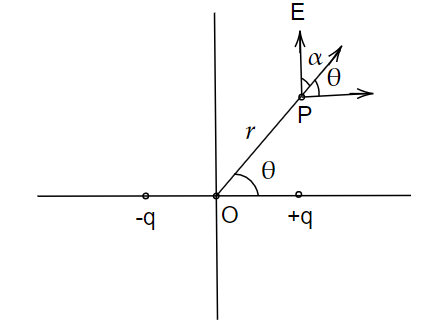
An electric dipole of the moment \[\overrightarrow P \] is placed at the origin along the x-axis. The angle made by the electric field with the x-axis at a point P, whose position vector makes an angle \[\theta \] with the x-axis, is (where \[\tan \alpha = \dfrac{1}{2}\tan \theta \])
A. \[\alpha \]
B. \[\theta \]
C. \[\theta + \alpha \]
D. \[\theta + 2\alpha \]
Answer
222k+ views
Hint: If we have two charges, one is positive and one is negative then, the electric dipole gives the direction of the flow of charges. That is, from negative charge toward positive charge. The electric field intensity is defined as a force experienced by a unit positive charge placed at some point in the electric field.
Formula Used:
To find the electric field the formula is,
\[E = \dfrac{P}{{4\pi {\varepsilon _0}}}\dfrac{1}{{{r^3}}}\sqrt {3{{\cos }^2}\theta + 1} \]
Where, P is electric dipole moment and r is distance between the two charges.
Complete step by step solution:

Image: An electric dipole moment placed at the origin along the x-axis.
Consider an electric dipole moment P which is placed at the origin along the x-axis. The angle made by the electric field with the x-axis at a point P, then we need to find the electric field.
For that we consider the diagram where the dipole is placed on the x-axis, now we have to find the electric field at point P. The position vector makes an angle \[\theta \] with the x-axis denoted by \[\overrightarrow r \] from point P to the dipole. Then the formula to find the electric field is given by,
\[E = \dfrac{P}{{4\pi {\varepsilon _0}}}\dfrac{1}{{{r^3}}}\sqrt {3{{\cos }^2}\theta + 1} \]
Further, we know that the electric field at the point P makes an angle\[\alpha \]with respect to the position vector and the angle \[\theta \] with respect to the x-axis. By this, we can say that the electric field at point P makes an angle of \[\alpha + \theta \] from the x-axis. Therefore, the position vector makes an angle \[\theta \] with x-axis is, \[\alpha + \theta \].
Hence, option C is the correct answer.
Note: Don’t get confused with the terms electric dipole and the dipole moment. When two opposite charges are kept at a certain distance from each other then the system is termed an electric dipole. The dipole moment is always a vector quantity with the direction being from the negative to the positive charge.
Formula Used:
To find the electric field the formula is,
\[E = \dfrac{P}{{4\pi {\varepsilon _0}}}\dfrac{1}{{{r^3}}}\sqrt {3{{\cos }^2}\theta + 1} \]
Where, P is electric dipole moment and r is distance between the two charges.
Complete step by step solution:

Image: An electric dipole moment placed at the origin along the x-axis.
Consider an electric dipole moment P which is placed at the origin along the x-axis. The angle made by the electric field with the x-axis at a point P, then we need to find the electric field.
For that we consider the diagram where the dipole is placed on the x-axis, now we have to find the electric field at point P. The position vector makes an angle \[\theta \] with the x-axis denoted by \[\overrightarrow r \] from point P to the dipole. Then the formula to find the electric field is given by,
\[E = \dfrac{P}{{4\pi {\varepsilon _0}}}\dfrac{1}{{{r^3}}}\sqrt {3{{\cos }^2}\theta + 1} \]
Further, we know that the electric field at the point P makes an angle\[\alpha \]with respect to the position vector and the angle \[\theta \] with respect to the x-axis. By this, we can say that the electric field at point P makes an angle of \[\alpha + \theta \] from the x-axis. Therefore, the position vector makes an angle \[\theta \] with x-axis is, \[\alpha + \theta \].
Hence, option C is the correct answer.
Note: Don’t get confused with the terms electric dipole and the dipole moment. When two opposite charges are kept at a certain distance from each other then the system is termed an electric dipole. The dipole moment is always a vector quantity with the direction being from the negative to the positive charge.
Recently Updated Pages
[Awaiting input: Please provide the content from "Ask AI Response," "Competitor 1," and "Competitor 2," so I can perform the analysis and synthesize the requested metadata and headings.]

States of Matter Chapter For JEE Main Chemistry

Mass vs Weight: Key Differences Explained for Students

Circuit Switching vs Packet Switching: Key Differences Explained

Conduction Explained: Definition, Examples & Science for Students

Balancing of Redox Reactions - Important Concepts and Tips for JEE

Trending doubts
JEE Main 2026: Application Form Open, Exam Dates, Syllabus, Eligibility & Question Papers

Derivation of Equation of Trajectory Explained for Students

Hybridisation in Chemistry – Concept, Types & Applications

Understanding the Angle of Deviation in a Prism

How to Convert a Galvanometer into an Ammeter or Voltmeter

Degree of Dissociation: Meaning, Formula, Calculation & Uses

Other Pages
JEE Advanced Marks vs Ranks 2025: Understanding Category-wise Qualifying Marks and Previous Year Cut-offs

Dual Nature of Radiation and Matter Class 12 Physics Chapter 11 CBSE Notes - 2025-26

Ideal and Non-Ideal Solutions Explained for Class 12 Chemistry

Understanding the Electric Field of a Uniformly Charged Ring

Understanding Atomic Structure for Beginners

Understanding Electromagnetic Waves and Their Importance




